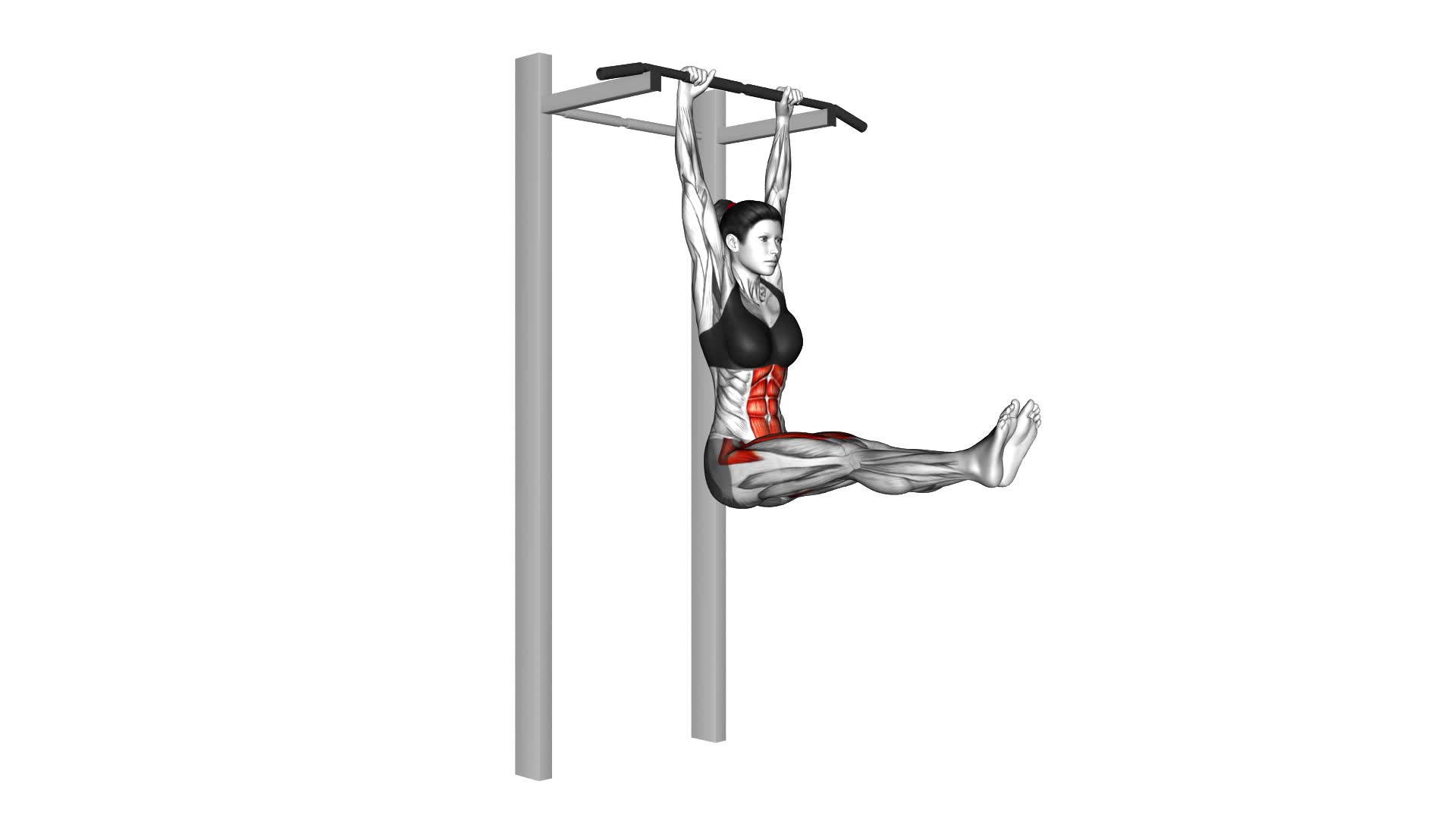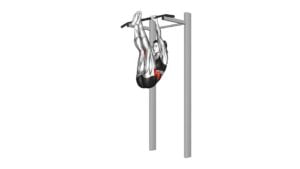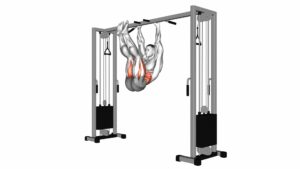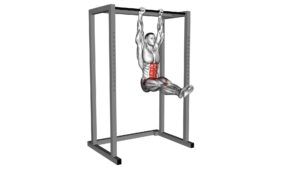Hanging Straight Leg Raise (female) – Video Exercise Guide & Tips

Are you looking to strengthen your core and increase your lower body strength? Look no further than the Hanging Straight Leg Raise.
Watch This Exercise Video
This exercise targets your abs, hip flexors, and lower back, giving you a full-body workout. In this article, we will guide you through the proper form and technique, provide tips to avoid common mistakes, and offer variations and progressions to challenge yourself.
Get ready to take your fitness to new heights with the Hanging Straight Leg Raise.
Key Takeaways
- Hanging Straight Leg Raise targets the abs, hip flexors, and lower back for a full core workout.
- Proper alignment and posture are essential for the exercise, focusing on a straight line from head to toe.
- Engaging the core muscles for stability and control is crucial to avoid swinging or using momentum.
- Core activation not only strengthens the abs but also improves balance, body control, and lower body strength.
Benefits of Hanging Straight Leg Raise
The hanging straight leg raise provides numerous benefits for women looking to strengthen their core and improve their overall fitness. This exercise primarily targets the abdominal muscles, specifically the rectus abdominis, which is responsible for the coveted 'six-pack' appearance. By performing hanging straight leg raises regularly, you can strengthen and tone your abs, leading to a stronger core and improved posture.
In addition to targeting the abs, hanging straight leg raises also engage the hip flexors, which are the muscles responsible for raising your legs. This exercise can help to improve hip flexibility and increase your overall range of motion. Strengthening the hip flexors can also be beneficial for activities such as running, jumping, and kicking.
To perform a hanging straight leg raise, start by hanging from a pull-up bar with your arms fully extended. Engage your core and lift your legs until they're parallel to the floor, then lower them back down with control. It's important to keep your legs straight throughout the movement and avoid using momentum to swing your legs up.
Setting Up for the Exercise
To set up for the exercise, grab a sturdy pull-up bar with your hands shoulder-width apart. This will provide a solid grip and stability during the Hanging Straight Leg Raise. Make sure the bar is secure and can support your body weight. If necessary, use gloves to improve your grip and prevent hand fatigue.
Before starting the exercise, check that the bar is at a height where your feet can hang freely without touching the ground. This will allow for a full range of motion during the exercise and prevent any unnecessary strain on your lower back.
No additional equipment is needed for the Hanging Straight Leg Raise. However, you may want to use a mat or towel to cushion your elbows if the bar is uncomfortable to grip.
Ensure that you have enough space around you to perform the exercise without any obstructions. This will prevent any accidents or injuries while executing the movement.
Proper Form and Technique
To perform the hanging straight leg raise with proper form and technique, it's important to focus on alignment and posture.
Make sure your body is in a straight line from head to toe, and avoid swinging or using momentum to lift your legs.
Engaging your core muscles is crucial for stability and control during the exercise.
Lastly, be mindful of avoiding lower back strain by using your abdominal muscles to initiate the movement and keeping your lower back flat against the floor.
Alignment and Posture
When performing the Hanging Straight Leg Raise exercise, it's important to maintain proper alignment and posture by engaging your core and keeping your legs straight throughout the movement. This exercise not only targets the abdominal muscles but also helps in improving flexibility.
To achieve the correct alignment, start by hanging from a pull-up bar with your arms fully extended and your shoulders relaxed. Engage your core by pulling your belly button towards your spine.
As you raise your legs, focus on keeping them straight and avoid any swinging or momentum.
As you lower your legs back down, maintain control and avoid arching your back.
Remember to breathe throughout the exercise and perform it at a controlled pace to ensure proper form and technique.
Core Engagement Importance
Engage your core properly to ensure proper form and technique during the Hanging Straight Leg Raise exercise. Core activation is crucial for maintaining stability and protecting your lower back. Here's why core engagement is important:
- Core stability: Activating your core muscles, including the abdominals, obliques, and lower back, helps stabilize your spine and pelvis during the exercise. This stability allows for controlled movement and reduces the risk of injury.
- Improved balance: Engaging your core helps improve your overall balance and body control. This is particularly important during exercises that involve lifting your legs, as it helps maintain proper alignment and prevents excessive swinging or momentum.
- Increased strength: By activating your core, you can generate more power and strength in your lower body, ultimately enhancing the effectiveness of the Hanging Straight Leg Raise.
Avoiding Lower Back Strain
Maintaining proper form and technique is essential to prevent lower back strain during the Hanging Straight Leg Raise exercise. By following these guidelines, you can effectively prevent back pain and strengthen your abdominal muscles.
First, make sure to engage your core throughout the entire exercise. This means tightening your abdominal muscles and keeping your back straight. Avoid arching or rounding your lower back, as this puts unnecessary strain on the spine.
Second, focus on controlled movements. Avoid swinging or using momentum to lift your legs. Instead, lift them up slowly and lower them back down in a controlled manner. This helps to target the abdominal muscles more effectively while reducing the risk of lower back strain.
Lastly, listen to your body. If you experience any discomfort or pain in your lower back, stop the exercise immediately. It's important to prioritize your safety and well-being while working out.
Common Mistakes to Avoid
To ensure you perform the hanging straight leg raise correctly and avoid common mistakes, it's important to focus on proper form demonstration.
This includes:
- keeping your legs straight
- engaging your core muscles
- controlling the movement throughout
Additionally, injury prevention techniques such as avoiding swinging or using momentum can help you maintain control and protect yourself from potential harm.
Proper Form Demonstration
Make sure you keep your legs straight and avoid swinging or using momentum during the Hanging Straight Leg Raise exercise. This will help you target your abdominal muscles more effectively and minimize the risk of injury. Here are some additional tips to ensure proper form:
- Proper Breathing: Remember to exhale as you lift your legs and inhale as you lower them. This will help stabilize your core and maintain control throughout the movement.
- Equipment Needed: To perform the Hanging Straight Leg Raise, you'll need a pull-up bar or a suspension trainer that allows you to hang freely.
By following these guidelines, you can maximize the benefits of this exercise and reduce the likelihood of strain or discomfort.
Now let's move on to the next section, where we'll discuss injury prevention techniques.
Injury Prevention Techniques
To avoid injury while performing the Hanging Straight Leg Raise, it's important for you to focus on proper technique and avoid common mistakes. Injury prevention techniques can help you maximize the benefits of this exercise while minimizing the risk of injury.
One common mistake to avoid is swinging your legs during the movement. This can strain the lower back and increase the risk of injury. Instead, focus on maintaining control and stability throughout the exercise.
Another mistake is using momentum to lift your legs instead of relying on your core muscles. This reduces the effectiveness of the exercise and increases the risk of injury.
It's also important to listen to your body and modify the exercise if necessary. If you experience any pain or discomfort, consider reducing the range of motion or using a support, such as a resistance band, to assist you.
Variations and Progressions
You can progress the hanging straight leg raise exercise by adding variations to challenge yourself further. Here are some advanced variations and modification options you can try:
- L-Sit Hanging Leg Raise: Instead of raising your legs straight in front of you, try lifting them up to form an L shape with your body. This targets your core and hip flexors even more.
- Hanging Knee Tucks: If straight leg raises are too challenging, you can start by bending your knees and bringing them towards your chest. This modification allows you to build strength and control before progressing to straight leg raises.
- Weighted Hanging Leg Raises: Once you've mastered the basic hanging straight leg raise, you can add weight to increase the difficulty. Hold a dumbbell between your feet or wear ankle weights to challenge your muscles even more.
Tips for Getting the Most Out of Your Workout
How can you maximize your workout to get the most out of your hanging straight leg raise exercise? To achieve maximum results and workout efficiency, follow these tips:
- Focus on proper form: Maintain a straight back, engage your core, and avoid swinging or using momentum. This ensures that your abdominal muscles are being targeted effectively.
- Gradually increase intensity: Start with a comfortable range of motion and gradually increase it as your strength improves. This helps to continually challenge your muscles and maximize the benefits of the exercise.
- Control the descent: Lower your legs slowly and under control, rather than allowing them to drop quickly. This engages your muscles throughout the entire movement and enhances the effectiveness of the exercise.
- Incorporate variations: Once you have mastered the basic hanging straight leg raise, consider adding variations to target different muscle groups. This includes bent knee raises, side raises, or twisting raises.
- Prioritize consistency: To maximize your results, perform the hanging straight leg raise exercise regularly. Consistency is key in building strength and improving overall fitness.
Frequently Asked Questions
How Many Repetitions of the Hanging Straight Leg Raise Should I Do in Each Set?
To determine the number of repetitions of the hanging straight leg raise you should do in each set, it's important to consider the number of sets and proper form. Find a comfortable pace that allows you to maintain good technique throughout the exercise.
Start with a manageable number of repetitions, such as 8-12 per set, and gradually increase as you become stronger and more comfortable. Remember, quality over quantity is key to avoiding injury and maximizing results.
Can I Do the Hanging Straight Leg Raise Exercise if I Have Lower Back Pain?
If you have lower back pain, it's important to be cautious when performing the hanging straight leg raise. Instead, you can try alternatives such as the lying leg raise or the knee tuck exercise.
These exercises can help strengthen your core without putting too much strain on your lower back.
Always listen to your body and consult with a healthcare professional for modifications specific to your condition.
Is It Necessary to Have a Pull-Up Bar to Perform the Hanging Straight Leg Raise?
Yes, it's possible to perform the hanging straight leg raise exercise without a pull-up bar. There are alternative equipment options available, such as using a suspension trainer or gym rings. These alternatives can provide similar benefits to the exercise, which include strengthening your core, hip flexors, and lower abs.
The hanging straight leg raise targets multiple muscle groups and can help improve your overall stability and balance.
How Long Should I Rest Between Sets of Hanging Straight Leg Raises?
To maximize muscle activation and prevent fatigue, it's important to rest between sets of hanging straight leg raises.
The rest duration will vary depending on your fitness level and goals. Generally, aim for a rest period of 1-2 minutes.
This allows your muscles to recover partially, ensuring that you can perform each set with proper form and intensity. Remember, the goal is to challenge your muscles, so don't rush the rest period.
Can I Incorporate the Hanging Straight Leg Raise Into My Abdominal Workout Routine?
Yes, you can definitely incorporate the hanging straight leg raise into your abdominal workout routine.
It's a highly effective exercise for targeting and strengthening the abs.
By hanging from a bar and raising your legs straight up, you engage the lower abdominal muscles and the hip flexors.
This exercise also helps to improve core stability and overall body control.
If you're looking for alternatives, you can try exercises like planks, reverse crunches, or knee tucks on a stability ball.
Conclusion
In conclusion, the hanging straight leg raise is a highly beneficial exercise that targets the core and lower body muscles. By following the proper form and technique, you can maximize the effectiveness of this exercise and avoid common mistakes.
Additionally, incorporating variations and progressions can help keep your workouts challenging and prevent plateaus. Remember to always listen to your body and consult with a professional trainer if needed.
Keep pushing yourself and enjoy the benefits of this powerful exercise.

Author
Years ago, the spark of my life’s passion ignited in my mind the moment I stepped into the local gym for the first time. The inaugural bead of perspiration, the initial endeavor, the very first surge of endorphins, and a sense of pride that washed over me post-workout marked the beginning of my deep-seated interest in strength sports, fitness, and sports nutrition. This very curiosity blossomed rapidly into a profound fascination, propelling me to earn a Master’s degree in Physical Education from the Academy of Physical Education in Krakow, followed by a Sports Manager diploma from the Jagiellonian University. My journey of growth led me to gain more specialized qualifications, such as being a certified personal trainer with a focus on sports dietetics, a lifeguard, and an instructor for wellness and corrective gymnastics. Theoretical knowledge paired seamlessly with practical experience, reinforcing my belief that the transformation of individuals under my guidance was also a reflection of my personal growth. This belief holds true even today. Each day, I strive to push the boundaries and explore new realms. These realms gently elevate me to greater heights. The unique combination of passion for my field and the continuous quest for growth fuels my drive to break new ground.



